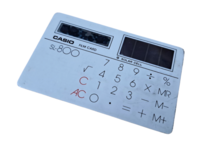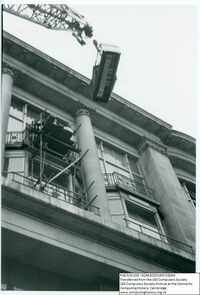Probably best known for their calculators, watches, and portable TVs, the company has also been producing computers for many years, being one of the companies to support the MSX standard.
Based in Shibuya, Japan, the company was founded in 1946 as Kashio Seisakujo, before becoming the Casio Computer Co Ltd in 1957.
Their first calculator was based on solenoids, and took up a large share of a desktop. It was released in 1954, and was Japan's first electro-mechanical calculator. An important innovation with this machine was the introduction of the ten key numerical pad.
After becoming Casio, the company released the Model 14A, which was the world's first all-electric calculator. It was expensive at 485,000 yen, and was based on relays.
By the 1980s Casio was producing handheld calculators worldwide. One of the more famous being the Casio M1, which ran off two AA batteries or mains power, and had functions such as square root.
Over the coming years, scientific calculators would be released, and a great many school children in the UK would use Casio machines to go through their O Level and GCSE exams. Millions have sold globally.
Digital watches have became a huge part of the companies business, with a massive range to suit any budget. From time pieces that only tell the time and date, up to models that contain a remote control for a TV and video. There were others models that are no longer available that contained an FM radio, complete with pull-out antennae.
Some of these watches such as the 1983 original G-Shock watch are highly sought after in the collectors market today, and the scratchproof AE-21 will also fetch hundreds of pounds on auction sites.
There are hundreds of models of watches aimed at both men and women, with many different colours and functions. Most are battery powered, and not just digital faces, but also analogue ones too.
Another large part of the Casio business is musical keyboards, which started appearing in the early 1980s. Probably the most famous of these was the VL-1 or the VL-Tone, which was a small handheld unit, that had a few features that made it a craze in school playgrounds around 1981. Firstly it had several different noises built in, such as piano and harp, then it had a rudimentary drum machine, of which the tempo could be altered. It also had the ability to record a tune and play it back. There were two blue keys that could be pressed concurrently to play a saved tune precisely. It also had the ability to alter the sounds in the machine, and of course there was also a calculator.
For the electronic entertainment market, the company produced LCD games, taking on the Game & Watch series from Nintendo. These were quite advanced in both gameplay and technically, and some even featured solar technology to power the machines, rather than rely on batteries.
Other products bought to market from the early 1980s were portable TV sets, film cameras, LCD handheld games, printers and alarm clocks, usually cheaper and with more features than their competitors.
Computer-wise the company made an attempt to enter the Japanese console market in 1983, with the PV-1000 machine. Only 13 games were released, and due to a late release, the machine came up against the Nintendo Famicom and the Sega SG-1000. Casio realised quickly that the machine was not going to compete, and withdrew it from sale after only a few months.
A computer followed using a similar spec to the console, this was the PV-2000, it had built-in BASIC CS-83, but only 4K of RAM, which through an expansion could be raised to 16K. This was also only released in Japan.
The PV-2000 was also not a success and like the PV-1000 before it, was not on the market long, and both are now very rare collector's items. Second-hand machines invariably have a disintegrated keyboard due to the vinyl used in its construction.
After these machines came the PV-7 and PV-16, which were the first to adopt the MSX standard, though the PV-7 only had 8K of RAM, so could not use MSX software unless an expansion unit was present (the KB-7). The PV-16 had more memory and was by far the most successful of the two. Again these machines did not make it past the Japanese market.
More MSX computers such as the MX-10 and MX-101 followed, the latter has a built in TV aerial, which broadcasts the computer to a TV with an aerial. The international version of the MX-10 is the MX-15.
In 1995, Casio again released a console - the Casio Loopy. Aimed at girls, it had the unique feature of having a sticker printer built in.
The company today continues to provide the worldwide market with watches, digital cameras, cash registers, laptops, mobile phones, and has also in the past produced PDAs and electronic diaries and dictionaries.
Timeline for Casio :
Hardware Products
 |
 |
 |
 |
 |
Casio FA-6
1990
The FA-6 Interface was used with the Casio FX-603P, Casio FX-840P, Casio FX-841P, Casio FX-850P, Casio FX-860P, Casio FX-860Pvc, Casio FX-870P, Casio FX-880P, Casio FX-890P, Casio VX-1, Casio VX-2, Ca...
Manufacturer : Casio
Type : Peripheral
|
|
 |
 |
 |
 |
Software Products
Promotional Items
Video Relating to Casio :
Photographs Relating to Casio :
Magazine Articles About Casio
|
|





































































